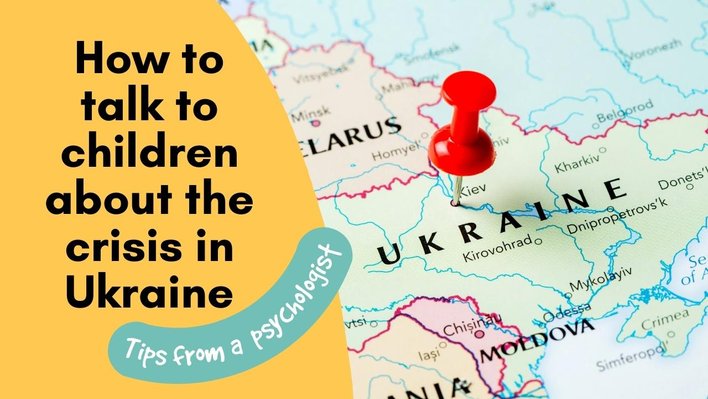If you are a parent, grandparent, teacher or educator, you might wonder: Should I talk to my children about distressing world events? When these issues arise, it can be hard to know if we should discuss them with our children. If we do, how should we discuss them?
Clinical Psychologist, Stephanie Chan from Annabelle Psychology, discusses her ideas on relating to kids about the Ukraine invasion, tailoring them based on their age and maturity. Also, we list some ways you can help the people of Ukraine.
3 reasons to to talk to kids about the war in Ukraine
1. To help children process difficult emotions that may arise.
While it seems like a good idea to downplay a stressful events as to avert anxiety or alarm, Stephanie cautions against that. She notes that children can be quite bright. When the issue is consistently dismissed, the child learns they cannot share these complex emotions with their parents.
Research suggests that a supportive discussion about the stressful event can actually reduce distress. It’s best to “name it to tame it.”
A child in a more expressive family perceives less threat from stressful events. These conversations provide you with an opportunity to reassure your child about what they might be feeling.
2. To check in, just in case.
Most children may have already seen or heard about the invasion of Ukraine in the form of pictures, videos or news reports. Stephanie encourages parents not to assume that children have not heard about it and instead, to check in with their children in an open and honest manner, for example “this fight in Ukraine is on the news, what do you think?”
This way, parents can confirm that the kids are not bothered by it at the time, or if they are, it can serve as another channel for them to process these emotions. Bringing up the conversation with your child allows you to talk about a shared plan and strategies that can help if they are feeling upset about it.
3. To model and encourage compassionate views towards others.
The discussion of the conflict in Ukraine can help children to learn compassion for others regardless of distance or circumstances. Talking with children about world events is a perfect opportunity to help them develop skills in looking beyond their own point of view and to help them understand the feelings, contexts, and perspectives of others in an age-appropriate manner.
Talking to children about the conflict in Ukraine
The information unfolding in Ukraine will be understood and processed differently by children depending on their age and maturity.
1. Choose easy-to-understand words and avoid going into unnecessary details
Start by asking your child what they have heard or what they might know about the conflict in Ukraine. Get some clarification on what their level of understanding is.
Children under the age of seven may have a very limited understanding of the conflict in Ukraine. “In our local context, children would not have the previous exposure to what war might look like” says Stephanie. “Explaining what war is might take too much context and maybe for some kids, would be too traumatising.” Stephanie suggests to call it a conflict or a fight instead.
Provide your young child with simple information about what is happening if he or she asks you a question. Avoid providing more detail than requested.
2. Use objective or descriptive language
Stick to the facts. Stephanie explains that when we use objective or descriptive language, we are describing things we can see with our eyes and experience with our sense. For example, you could say “one country is not being very nice to another country and it is making people feel upset.”
Anything that has an element of our own interpretation, our own opinion, that will be considered as more judgmental language. Young children are impressionable and they will take on these value judgements instead of forming thinking patterns for themselves.
3. Validate and normalise how they are feeling
If they say it’s distressing for them, you can say: “It can be scary to think about a war; most kids and adults feel scared too.” If your child does not know very much or does not seem to be very disconcerted about what is happening, you can keep the discussion brief.
Stephanie reminds us, “to take the mindset that I am here to listen to my child. I’m not here to correct any thoughts or change any judgement. I just want to let my child know that I’m present for them.”
Being worried or scared is very human process, and children need to know that. To help children process these emotions, Stephanie suggests asking, “Is it okay if I share more information so you can get a better picture of it?”
4. Pay attention to non-verbal cues
Some children will keep their fears and concerns to themselves, so look for changes in their behaviour. This includes:
- Regression. Stephanie gives the example of a seven-year-old child who is toilet trained but wets the bed three or four nights in a row
- Becoming overly clingy or grumpier
- Exhibiting academic or social difficulties. An outgoing, normally social child suddenly unwilling to interact with others
- Behavioural changes like throwing tantrums or lashing out More withdrawn and non-verbal
Stephanie asserts the importance of reassuring the child that even though these behaviours are happening, parents convey that they are not taking a punishing stance. A parent can gently say, “I noticed that last time you’re able to do this well but now you seem to struggle a bit. Is that something I can help you with? Can you let me know what’s wrong?”
Then when they do, to validate and reassure them that mum and dad are here to help guide them through.
Children also need to be given the autonomy to say they do not wish to talk about it because they’re not ready. Allow them to do that and let them know it’s okay. Assure them that whenever they are ready, mom and dad will be there to listen and help them process.
5. Be mindful of your own emotions and model how you process them
Children can sense when their parents are sad or unhappy, even if it seems they are oblivious to it. Pretending that everything is okay implies that strong emotions like anger, irritation, or sadness must be suppressed. Stephanie cautions that, “as the child continues to develop and grow, they will not go to mom and dad with these emotions because what they have been taught indirectly is that these emotions must not be aired or expressed.”
She explains that if parents can describe their feelings in a descriptive and objective way, then the child learns that it’s okay to be sad and not put on a front. Parents can show their children how to feel their feelings without reacting to their heightened emotions, such as fear or anger.
Ultimately, by having these conversations, you show your child that you are willing and open to having discussions, even when times are tough. This can help build a lasting foundation to talk about difficult topics.
How to help Ukraine
Organisations on the ground helping Ukrainians include:
ADRA: providing urgent humanitarian aid in Ukraine including water, food, shelter, blankets and clothing. Also working in surrounding countries, including Poland, Romania and Hungary, as they prepare to respond to the needs of incoming refugees. Watch this video to see how ADRA is helping.
UNICEF: trucking safe water to conflict-affected areas and prepositioning health, hygiene and emergency education supplies as close as possible to families near the contact line.
Save the Children: providing children and families with immediate aid, such as food, water, hygiene kits, psychosocial support and cash assistance.
UNHCR: ensuring that those who are forced to flee their homes in Ukraine are sheltered and safe.
Click here to watch an excerpt of our interview with Stephanie on how to talk to children about the Russia-Ukraine conflict.
Stephenie Chan is a registered clinical psychologist who practices at Annabelle Psychology and Annabelle Kids.



